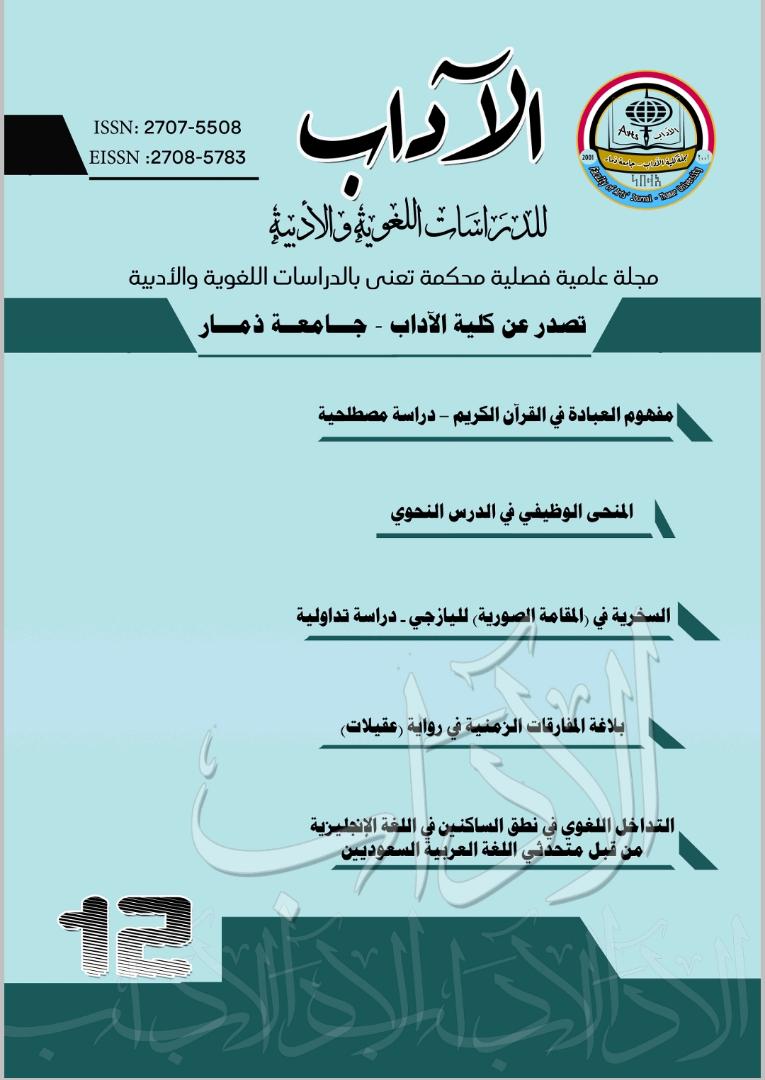Interlanguage Cluster Production of L2 English by L1 Saudi Arabic Speakers
DOI:
https://doi.org/10.53286/arts.v1i12.786Keywords:
L2 Phonology,, Pseudowords, Markedness, Phonological Category, Phonological constraintsAbstract
This study aimed to provides an in-depth phonological analysis of the utterance of L2 coda clusters by Saudi Arabic second language (L2) English learners. Research in the domain of L2 phonetics and phonology show that L2 learners encounter difficulties in producing coda clusters. These studies investigated L2 learners whose native language disallowed codas or have restricted phonological construction for the coda. Therefore, the present study takes a step forward and conducts a controlled phonological investigation. It is divided into four sections, introduction to the subject of the study, literature, methodology, and finally results and discussion. It focuses on Saudi learners whose L1 Arabic allows complex codas. The research data came from 15 ESL students at an intermediate proficiency level. The task was to read pseudowords with controlled sonority distance between the targeted consonants. The results show some L1 transfer coda constraints; specifically, even though Arabic allows complex coda clusters, the subject had difficulties in producing some English codas. Yet, overall, there was no effect of markedness according to the sonority scale. The subjects’ phonological proficiency develops in L2, and their L2 phonological constraints are re-ranked towards L2-like production.
Downloads
References
References:
Al-Ani, S., Arabic Phonology: An Acoustical and Phonological Investigation. The Hague: Mouton publisher, Paris 1979.
Alotaibi, A., Pronunciation Problems in the Production of the Voiced Labiodental Fricative /v/ by Saudi speakers of English. Unpublished master’s thesis. Southern Illinois University Carbondale, Carbondale, Illinois, USA 2013.
Burquest, D. A., & Payne, D. L., Phonological analysis: A functional Approach. Summer Institute of Linguistics. Dallas, TX, USA 1993.
Broselow, E., Chen, S., and Wang, C., The Emergence of the Unmarked in Second Language Phonology. Studies in Second Language Acquisition, 20, 261–80, 1998.
Benson, B., Universal Preference for the Open Syllable as an Independent Process in Interlanguage Phonology. Language Learning, 38, 221-242, 1988.
Dinnsen, D., & Eckman, F. A functional explanation of some phonological typologies. In R. Grossman, J. San & T. Vance (Eds.), Papers in Functionalism (pp. 126-134). Chicago Linguistic Society, Chicago, 1975.
Eckman, F. R., Markedness and The contrastive Analysis Hypothesis. Language Learning: Journal of Linguistic Study research, 27(2), 315–319, 1977.
Gierut, J. A., Phonological Complexity and Language learnability. American Journal of Speech-Language Pathology, 16 (1), 6–17, 2007.
Hancin-Bhatt, B., Optimality In Second Language phonology: codas in Thai ESL. Second Language Research, 16(3), 201-232, 2000.
Jabbari, A., & Samavarchi, L. Persian learners’ syllabification of English consonant clusters. International Journal of English Linguistics, 1, 236-246, 2001.
Kharma, N., & Hajjaj, A., Errors of English among Arabic speakers. Alfred Place, London, 1989.
Knoebel, S., Hmong production of word-final obstruents in English as a function of language transfer, universal tendencies, and attention paid to speech. Unpublished master’s thesis, University of Minnesota, USA 1986.
Lado, R., Linguistics Across Cultures: Applied Linguistics for Language Teachers. The University of Michigan Press, Michigan 1957.
Ladefoged, P., and Johnson, K., A course in Phonetics. Wadsworth, Boston, USA, 1993.
Nathan, Geoffrey S., Phonology: A cognitive grammar introduction. John Benjamins Publishing Company, Philadelphia, Amsterdam, 2008.
Piske, T., Mackay, I. R. A., & Flege, J. E., Factors affecting degree of foreign accent in an L2: A review. Journal of Phonetics, 29, 191-215, 2001.
Steve, P., The Sonority Controversy. De Gruyter Mouton Boston, Berlin, 2012.
Downloads
Published
How to Cite
Issue
Section
License

This work is licensed under a Creative Commons Attribution 4.0 International License.
Copyright and Licensing
copyright is retained by the authors. Articles are licensed under an open access Creative Commons CC BY 4.0 license, meaning that anyone may download and read the paper for free. In addition, the article may be reused and quoted provided that the original published version is cited. These conditions allow for maximum use and exposure of the work.



